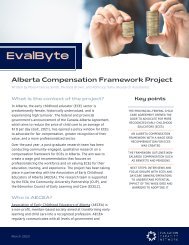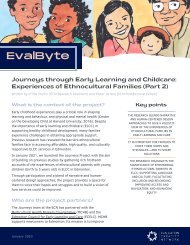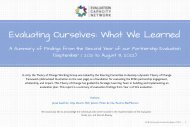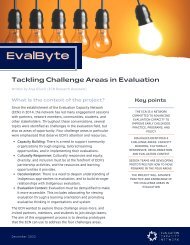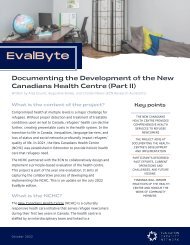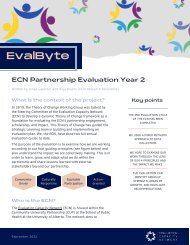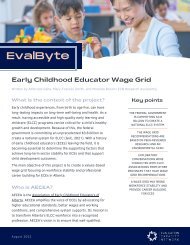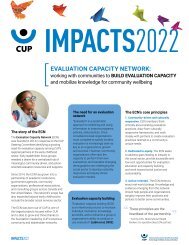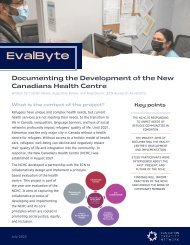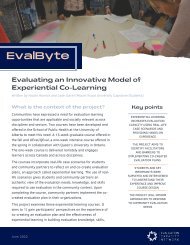Research Report 2019
You also want an ePaper? Increase the reach of your titles
YUMPU automatically turns print PDFs into web optimized ePapers that Google loves.
CHANGE WITH<br />
COMMUNITIES<br />
<strong>2019</strong> RESEARCH HIGHLIGHTS
Catalyzing<br />
Change<br />
T<br />
he Faculty of Extension’s distinguishable<br />
academic purpose is to build and nurture<br />
enduring relationships with local, national, and<br />
global partners for social change. All of our work<br />
coalesces to catalyze change with communities<br />
and place the Faculty at the forefront of community<br />
engagement. Our partnerships reimagine urban<br />
and rural living, life for the young and old, and life in<br />
local and international communities, with reverence<br />
to cultural and Indigenous wisdoms. Above all, our<br />
work cares for and nurtures our relationships and<br />
how we engage with each other, embodying the<br />
practice and study of community engagement.<br />
The theme of this year’s research report is<br />
Shaping Our Cities and Towns. While some of our<br />
research is explicitly in partnership with municipal<br />
governments, other research indirectly shapes<br />
the cities and towns in which we live and care so<br />
deeply about.<br />
The stories in this report reflect the work of those<br />
who care for our land, food, space, governments,<br />
community organizations, and those living with<br />
inequity. As Associate Dean, <strong>Research</strong>, I am<br />
humbled to be surrounded by my colleagues and<br />
their community partners, who work each day to<br />
make life better for all.<br />
Maria Mayan<br />
Associate Dean, <strong>Research</strong><br />
Table of<br />
Contents<br />
4 Strength in Community<br />
6 More United Approach Needed to<br />
Provide a ‘Good Death’ to Rural<br />
Residents Who Wish to Die at Home<br />
8 Collaborating to Cultivate a Local<br />
Food System<br />
10 Evaluation Capacity<br />
12 Grocery Run<br />
14 Transforming How We Think<br />
About Heritage<br />
16 A Return to the Land<br />
19 Professoriate<br />
20 Adjunct Professors<br />
21 <strong>Research</strong> Centres<br />
22 Graduate Programs<br />
23 A Message to Our Donors<br />
2<br />
3
IN<br />
COMMUNITY<br />
Combatting the Stigma<br />
and Isolating Effects<br />
M<br />
ost of us can name someone with<br />
dementia or Alzheimer’s disease.<br />
Over half a million Canadians are<br />
living with dementia, according to the<br />
Alzheimer Society of Canada, and that<br />
number continues to grow.<br />
“As dementia progresses, a very strong<br />
trend is social isolation of the informal<br />
caregiver and the person living with<br />
dementia,” says Helen Lightfoot, a<br />
graduate student at the Faculty of<br />
Extension. Lightfoot explains that<br />
people are often unsure about how to<br />
interact with people who have dementia.<br />
“One of the things that people say<br />
disappears is their community after a<br />
dementia diagnosis. Friends and family<br />
are key supports and when they are lost,<br />
the rest of the network is weakened.”<br />
From her own experience and<br />
background in the health sector,<br />
Lightfoot has known people with<br />
dementia who have been supported by<br />
the community and enjoyed a higher<br />
quality of living. Some people with<br />
dementia in early stages still go about<br />
their daily routine, stopping at habitual<br />
spots such as the bank or a coffee shop.<br />
“The people at each place would help<br />
them out,” she recalls. “That kind of<br />
support builds strength—so how can<br />
we reduce the stigma and help the<br />
community provide support?”<br />
One way community members can start<br />
helping people with dementia, Lightfoot<br />
advises, is to start by listening to their<br />
story. “Often they just want someone<br />
to talk to or a way to contribute. We<br />
can look at what we can do to make<br />
connections and provide support.”<br />
Working with her Faculty of Extension<br />
supervisor, Kyle Whitfield, Lightfoot<br />
decided to examine what is the role<br />
of support networks in the lives of<br />
informal caregivers (often family<br />
members) who look after people<br />
with dementia. She asked informal<br />
caregivers how they view support<br />
and what factors influence the role of<br />
support networks.<br />
Interviews with informal caregivers<br />
revealed that their support networks<br />
provide five main types of support:<br />
advocacy, education, caregiving, access<br />
to resources, and coordination of<br />
supports. Lightfoot explains that their<br />
“support networks are attempting<br />
to play these roles while adapting to<br />
the loss of the main support person<br />
to dementia and a withdrawal of the<br />
community.” This finding indicates<br />
the importance of community in<br />
strengthening support networks and<br />
improving resiliency to overcome<br />
“gaps” in the network when individuals<br />
are diagnosed with dementia.<br />
Lightfoot’s research as part of her<br />
master’s studies in community<br />
engagement builds on the work from<br />
her previous position as a manager<br />
of the Westview Home Care Program<br />
in Stony Plain and Spruce Grove. She<br />
even received some funding from<br />
Alberta Health Services’ professional<br />
development fund in support of her<br />
master’s program.<br />
Her research also complements her<br />
involvement with the Westview Dementia<br />
Friendly Community Collaborative<br />
project (funded by Seniors Health,<br />
Strategic Clinical Network, Alberta<br />
Health Services). The project involved<br />
talking with people who have dementia<br />
and their families to find out what<br />
support is needed and what barriers<br />
exist. The results revealed three areas<br />
in which those with dementia wanted<br />
a greater opportunity to participate:<br />
physical and recreational activities,<br />
ability to use transportation, and ways to<br />
give caregivers a break. The community<br />
also came together at a town-hall<br />
meeting to brainstorm ideas on how to<br />
help those with dementia be part of the<br />
community, leading to the development<br />
of a recreational program and plans for<br />
other activities, such as a choir group<br />
and an art program.<br />
Lightfoot points out that while a cancer<br />
diagnosis has a pathway to refer people<br />
to support, dementia doesn’t, leaving<br />
people unsure of where to find answers<br />
and support. The Alzheimer Society of<br />
Alberta and Northwest Territories’ First<br />
Link program is a start to providing<br />
early support and guidance, but<br />
community awareness and involvement<br />
are key to ensuring that individuals with<br />
dementia and their caregivers do not<br />
become socially isolated.<br />
of Dementia<br />
4<br />
5
More United Approach<br />
Needed to Provide a ‘Good<br />
Death’ to Rural Residents<br />
Wishing to Die at Home<br />
<strong>Research</strong>er Finds One Rural Community Rallied<br />
Together to Support Terminally Ill Residents<br />
R<br />
ural communities have to take the<br />
lead in giving their terminally ill<br />
residents a “good death” at home rather<br />
than relying solely on the government,<br />
says a University of Alberta expert.<br />
It’s becoming a keenly felt issue for many<br />
small, under-resourced hamlets and<br />
towns hit by shrinking health care like<br />
doctor shortages and hospital closures,<br />
said Faculty of Extension community<br />
planning researcher Kyle Whitfield.<br />
“We aren’t planning ahead. We’re<br />
reacting—and we’re reacting much too<br />
slowly to the need that’s growing quickly.”<br />
In a case study of one Alberta town,<br />
Whitfield found that volunteers had to<br />
take on the work of planning hospice<br />
care for their families, friends, and<br />
neighbours to stay in the community<br />
to die.<br />
“It’s a phenomenon that’s occurring<br />
at a high rate; in Alberta you’re going<br />
to find hospice societies made up of<br />
citizens coming together to plan for<br />
their own communities. They are really<br />
having to come together to plan for their<br />
own health-care needs because of the<br />
downloading of government support onto<br />
the shoulders of these people. They are<br />
having to find ways to provide support for<br />
end-of-life care, because it isn’t there,”<br />
said Whitfield.<br />
Yet the need is growing for meaningful<br />
hospice care—a major health service—<br />
that allows people a good death: being<br />
surrounded by loved ones in their home<br />
communities during their final days.<br />
The number of people choosing to die in<br />
hospitals is dwindling, Whitfield noted.<br />
One recent U of A study found that only<br />
44 per cent of deaths in Canada are<br />
taking place in a hospital.<br />
“We are moving away from hospitals,<br />
which aren’t necessarily about death<br />
and dying,” Whitfield said. “People are<br />
choosing to die at home, and that’s their<br />
right. Why should someone have to go to<br />
a big-city hospital to die, when they could<br />
have health care and support services<br />
in their own community? Saying where I<br />
want to die is one of the most important<br />
characteristics of what a good death is.”<br />
The community she studied, which has a<br />
population of 8,600, found itself rallying<br />
to provide that for its citizens. In one<br />
case, the hospice society lined up people<br />
to sit with a dying woman who was asked<br />
what her biggest fear was.<br />
“It was being alone; she did not<br />
want to be alone when she died. So<br />
they arranged for around-the-clock<br />
volunteers to be at her side. They all took<br />
shifts to be with this lady. And she did<br />
not die alone. This community responded<br />
to the needs of someone being able to<br />
die with absolute dignity, comfort, and<br />
compassion,” said Whitfield.<br />
While some rural communities have<br />
nursing homes, that doesn’t necessarily<br />
meet the need for good end-of-life care,<br />
she noted.<br />
“It’s not a duplication of service to have<br />
a hospice, because it’s not the same<br />
service that’s being provided,” explained<br />
Whitfield. “It’s a space where the care<br />
needs are met from a broader, homelike<br />
perspective which is harder to provide in<br />
a nursing home.”<br />
The community originally wanted to<br />
build a hospice facility but realized that<br />
was beyond reach. Instead, over two<br />
years, it established a formal society,<br />
held fundraisers, applied for grants, and<br />
created a network of bedside volunteers<br />
to support the dying and their families.<br />
It showed the strength of the<br />
community’s efforts, Whitfield said.<br />
“There was grassroots support, they got<br />
donations from citizens and businesses<br />
to train volunteers, they had people<br />
attending talks about end-of-life care.<br />
That propelled the group forward and it<br />
shows how rural communities do more<br />
with less by building their own resources<br />
and capacities,” Whitfield said.<br />
But they shouldn’t have to do it alone,<br />
she added. The case study revealed the<br />
community had difficulty trying to meet<br />
with the province about its needs.<br />
“The government was not open to<br />
collaborating as easily as it could have<br />
been. There wasn’t any direction or<br />
step-by-step guide on how a community<br />
should respond to hospice care needs,”<br />
she said.<br />
There was also debate within the<br />
community about whose job it is to<br />
provide in-place care for the dying,<br />
Whitfield noted.<br />
“There was real confusion around<br />
whose role it is to address hospice<br />
care needs. Should it be community or<br />
should it be government?”<br />
What’s needed is a mix of both, in the<br />
form of a “multi-pronged approach,”<br />
Whitfield said.<br />
“You can’t deny rural communities<br />
their role in this. We need their<br />
perspectives on end-of-life care.<br />
They don’t necessarily want the<br />
government to come in and control the<br />
process, but we need a more united<br />
approach with government, community,<br />
and health-care support. It’s not an<br />
either-or situation.”<br />
Story Credit: This article originally appeared<br />
on folio.ca.<br />
6<br />
7
COLLABORATING<br />
TO CULTIVATE<br />
FOOD SYSTEM<br />
The Alberta Flavour<br />
Learning Lab as an<br />
Innovative Community<br />
of Practice<br />
I<br />
n response to growing demand<br />
for local food, several local food<br />
stakeholders are now working<br />
together in a more coordinated way to<br />
serve up more of what Alberta has to<br />
offer to Edmontonians.<br />
“The food system is a system and we<br />
can’t just work in corners,” said Mary<br />
Beckie, an associate professor and food<br />
systems researcher with the Faculty of<br />
Extension. “We have to acknowledge<br />
the system and all players to be able to<br />
scale up.”<br />
Thanks to the Alberta Flavour Learning<br />
Lab, its member organizations have<br />
been able to purchase more local food.<br />
In 2015, 23.9 per cent of their aggregated<br />
food purchases were Alberta-produced<br />
or processed foods. That number<br />
continues to grow each year, and is as<br />
high as 35 per cent for some institutions.<br />
The City of Edmonton and Northlands<br />
Agricultural Society initiated the<br />
Alberta Flavour Learning Lab in 2014,<br />
inviting a broad range of local food<br />
stakeholders to form a community<br />
for learning about local food, sharing<br />
expertise, and taking joint action with<br />
the mutual goal of “getting more local<br />
foods on more local plates.”<br />
“We made the case for working as a<br />
collective rather than as competitors,”<br />
said Beckie.<br />
Beckie has been involved with the<br />
Alberta Flavour Learning Lab from<br />
the start, leading the research and<br />
evaluation of the initiative. What she<br />
refers to as the “social infrastructure”<br />
has been a key factor in the current<br />
success of the Learning Lab, indicating<br />
the “importance of relationships,<br />
working together, meeting regularly, and<br />
building knowledge together.”<br />
Institutional food buyers, distributors,<br />
processors, producers, and governments<br />
all make decisions that can impact<br />
support for local foods and sustainable<br />
food systems. With representatives from<br />
these different groups meeting regularly,<br />
the Learning Lab working group has<br />
been able to create a shared definition of<br />
local food (to mean “Alberta food”) with<br />
criteria that make it easier to identify<br />
local food and facilitate procurement.<br />
The group has also been able to<br />
address knowledge gaps together<br />
and increase awareness of local<br />
food available in Alberta with<br />
opportunities such as “Meet the<br />
Maker” and food tours. These<br />
opportunities not only provide a way<br />
for food buyers to connect with local<br />
producers and processors, but also<br />
provide information to government<br />
representatives who develop<br />
assistance programs for local<br />
farmers and processors.<br />
The Learning Lab plays a role in<br />
creating a more resilient and robust<br />
local community and economy. “The<br />
more reliant we are on food from other<br />
places, the more vulnerable we are to<br />
environmental, economic, or political<br />
changes that might restrict our access to<br />
that food,” explained Beckie.<br />
“As we strive to cultivate sustainability and<br />
drive change in the greater food system,<br />
the challenge is creating the critical<br />
social space and supports to shift food<br />
purchasing practices and processes.”<br />
To support more informed and advanced<br />
food planning and policy, Beckie has<br />
also been working with the Institute for<br />
Sustainable Food Systems at Kwantlen<br />
Polytechnic University to launch the<br />
Alberta Municipal Local Food System<br />
Policy Database. This online searchable<br />
database includes valuable resources,<br />
such as municipal development plans,<br />
bylaws, and food strategies, collected<br />
from over 25 local governments.<br />
Planners, policy makers, researchers,<br />
and community advocates can use the<br />
database to research and advance food<br />
system planning in their regions.<br />
Beckie is the academic lead for the<br />
Western Canada arm of Food: Locally<br />
Embedded, Globally Engaged (FLEdGE),<br />
with her work in Alberta focused<br />
on exploring regional food systems,<br />
particularly the role of the social<br />
economy and municipal and provincial<br />
government in promoting local food.<br />
The research “Creating a Local Food<br />
Procurement Community of Practice:<br />
The Alberta Flavour Learning Lab”<br />
was published in a special issue on<br />
institutional procurement in the journal<br />
Canadian Food Studies.<br />
8<br />
9
Evaluation Capacity<br />
A Critical Tool for Social Innovation<br />
I<br />
n recent years, increasing pressures<br />
on community-based organizations to<br />
demonstrate accountability and success<br />
have led to an increase in evaluation<br />
demand and the need for expertise<br />
and support. The Evaluation Capacity<br />
Network (ECN), an interdisciplinary<br />
and intersectoral collaborative at the<br />
Faculty of Extension, is working to<br />
meet this need by developing several<br />
community-engaged capacity-building<br />
and learning opportunities.<br />
The ECN bridges communityuniversity<br />
evaluation gaps, serving<br />
as a central space where students,<br />
researchers, government, and<br />
community organizations can share<br />
and access evaluation expertise,<br />
resources, educational opportunities,<br />
and networks. Originating from<br />
conversations in the field of early child<br />
development, the ECN has expanded<br />
the network, drawing on intersecting<br />
relationships that have led to a broader<br />
reach across the social sector.<br />
The ECN promotes critical learning<br />
and reflection about evaluation, and<br />
supports partners in generating and<br />
collecting valuable information about<br />
the relevance and effectiveness of their<br />
programs, policies, and practices. The<br />
overall aim is to positively impact the<br />
lives of children, youth, families, and<br />
broader society.<br />
“In working in deep relationship<br />
and partnership on evaluation<br />
with organizations, their staff, and<br />
participants, we’ve seen organizations<br />
build their capacity to gather<br />
meaningful evidence and use it to shift<br />
practice, programs, and policies in their<br />
organization,” said Rebecca Gokiert,<br />
Director of the ECN.<br />
UEval, Eval Lab, and Evaluating Refugee<br />
Programs are a few of the capacitybuilding<br />
initiatives currently being run<br />
under the ECN. Each program is unique<br />
in how it builds evaluation capacity<br />
among different groups.<br />
Hands-on Learning for Students and<br />
Community Members<br />
A new initiative of the ECN, UEval<br />
is a one-week institute that brings<br />
undergraduates, graduates, and<br />
community professionals together for a<br />
unique co-learning experience focused<br />
on evaluation in practice. Using an<br />
experiential learning approach, UEval<br />
engages learners in the exploration of<br />
evaluation theory and principles within<br />
a community context, enabling them<br />
to apply their learning in developing<br />
evaluative responses to communityinformed<br />
cases.<br />
In addition to UEval, graduate students<br />
taking evaluation courses in other<br />
faculties are given the opportunity to<br />
gain tangible and applied evaluation<br />
experience by connecting to local<br />
organizations with evaluation needs.<br />
Once matched with an organization,<br />
students help to develop evaluation<br />
plans, logic models, and data collection<br />
tools, such as interview guides, as<br />
needed. Students learn flexibility as<br />
they apply theory to complex community<br />
contexts, and partners benefit from the<br />
work students produce.<br />
Kelly Tyler, Project Manager at the<br />
Alberta Ministry of Justice and the<br />
Solicitor General has worked with three<br />
students over four years through the<br />
ECN brokering initiative. “The students<br />
bring a fresh perspective to the work,<br />
asking questions and uncovering<br />
assumptions; that creates learning on<br />
both sides.”<br />
“The Evaluation Capacity Network<br />
student program has created<br />
opportunity for relationships between<br />
the University and government,” Tyler<br />
added. “The relationship has been of<br />
great value and helps both students and<br />
government to develop capacity in the<br />
area of evaluation.”<br />
Supporting Professionals in<br />
Evaluation Practices<br />
To further support professionals in<br />
their evaluation practice, the Eval<br />
Lab was developed and is offered in<br />
partnership by the ECN, Edmonton<br />
Chamber of Voluntary Organizations,<br />
and Alberta Culture and Tourism.<br />
Over six full-day sessions, non-profit<br />
sector professionals come together<br />
to collaboratively deepen their<br />
understanding of evaluation, reflective<br />
practice, and critical learning. Meeting<br />
over a longer time span also offers<br />
participants the opportunity to test<br />
and apply evaluation concepts and<br />
tools within their organizations<br />
as needs arise. Coming together<br />
to explore and critically reflect on<br />
evaluation helps improve the quality<br />
of information collected within the<br />
participant organizations, to more<br />
clearly articulate and learn from what<br />
is working and what is not working in<br />
current programs.<br />
With the increased need for evaluation<br />
in the non-profit sector, Eval Lab offers<br />
an affordable and accessible resource<br />
for organizations often lacking the<br />
resources to meet these needs.<br />
Bethan Kingsley, an adjunct professor<br />
in the Faculty of Extension and Eval<br />
Lab facilitator, sees immense potential<br />
in the program. “Eval Lab can play a<br />
role in the broader transformation of<br />
a sector that uses data to engage in<br />
critical reflection to improve research,<br />
policies, and practices.”<br />
After a successful Eval Lab in 2018,<br />
the next Eval Lab will be offered in<br />
October <strong>2019</strong>.<br />
Evaluating Refugee Programs<br />
in Canada<br />
The ECN is also working in partnership<br />
with the Centre for Community Based<br />
<strong>Research</strong> (CCBR) in Waterloo to build<br />
evaluation capacity in the refugeeserving<br />
sector. Funded by Immigration,<br />
Refugee and Citizenship Canada, and in<br />
response to the recent influx of refugees<br />
entering Canada, this initiative will<br />
support the development of national<br />
capacity-building opportunities for<br />
programs serving refugees and<br />
refugee claimants.<br />
Jason Daniels, ECN co-investigator<br />
and a team lead on this initiative, hopes<br />
to promote “participatory evaluation,<br />
empowerment evaluation, and shared<br />
power relationships,” through the<br />
facilitated in-person evaluation<br />
workshops and mentorship ‘pools’ for<br />
refugee program staff that are being<br />
developed across Canada.<br />
This project aims to build sustainable<br />
evaluation practices within current<br />
programs in the refugee-serving sector.<br />
To Community and Beyond<br />
The ECN continues to evolve with shifting<br />
evaluation needs, to reflect what is<br />
practical and meaningful to community<br />
organizations, government agencies, and<br />
the social sector as a whole.<br />
In guiding meaningful evaluation<br />
practices across the social sector,<br />
Kingsley believes there is a need to<br />
question our desire for evaluation, to<br />
ensure data is not collected for its own<br />
sake but in a way that can truly inform<br />
programs, policies, and practices. “We<br />
need to ask ourselves, why are we<br />
collecting data, and does it really help<br />
us to understand something in a way we<br />
couldn’t have known before? By asking<br />
ourselves this question, we can reduce<br />
what is currently a significant data<br />
burden on non-profits and the individuals<br />
they are trying to serve.”<br />
Reflection, promoting evaluative<br />
thinking, and an openness to learn have<br />
allowed the ECN team to be successful<br />
and create learning opportunities with<br />
significant impact for partners and the<br />
greater community.<br />
To learn more about ECN and related programs or resources, visit:<br />
evaluationcapacitynetwork.com<br />
10 11
GROCERY<br />
Food Program Offers<br />
Lifeline to Immigrant and<br />
Refugee Families in Need<br />
w<br />
hen Marilena arrived in Edmonton<br />
from Romania five years ago<br />
to join her husband, she weighed 70<br />
kilograms. Six months later, the couple<br />
split up and she was left to fend for<br />
herself and their young son. Her weight<br />
soon dropped almost 20 kilograms.<br />
“I was starved,” she said. “First for me,<br />
it was important for my son to have<br />
something to eat. Then if something<br />
remained in his bowl, I ate it myself.”<br />
Struggling with her English skills and<br />
an economics degree not recognized<br />
in Canada, Marilena was grateful for<br />
social assistance that covered rent<br />
—but it didn’t stretch to cover food.<br />
When she connected with the Grocery<br />
Run, a program that provides healthy<br />
rescued food from store shelves, it was<br />
a lifesaver. She continues to rely on it to<br />
feed herself and her child as she takes<br />
English language classes and gets her<br />
new life on track.<br />
Providing Food While Reducing<br />
Food Waste<br />
Marilena’s situation—and that of<br />
other immigrant moms grappling<br />
with food insecurity—is at the heart<br />
of a problem-solving partnership led<br />
by researchers at the University of<br />
Alberta’s Faculty of Extension. Grocery<br />
Run is one of the results.<br />
“This is a food waste reduction strategy<br />
that is really just a creative way to get<br />
food directly to families who need it,”<br />
said lead researcher Maria Mayan, who<br />
studies poverty.<br />
The stop-gap program was started in<br />
response to the overwhelming need<br />
women and their families had for<br />
same-day food, said Sandra Ngo, initial<br />
coordinator of the Grocery Run program<br />
and U of A alumna in nutritional science<br />
and agricultural economics.<br />
Grassroots community workers with<br />
Edmonton’s Multicultural Health<br />
Brokers Co-operative were working<br />
holistically with these families to secure<br />
housing and income assistance, but<br />
instead found themselves scrambling to<br />
find emergency food—often using their<br />
own money to buy enough for evening<br />
suppers and school lunches.<br />
“The food insecurity piece was really<br />
hampering their efforts, taking away<br />
from what the brokers were already<br />
trying to do,” Ngo said.<br />
Mayan teamed with the co-operative<br />
in 2013, and through a U of A nutrition<br />
research project for pregnant and<br />
postpartum women in Alberta called<br />
ENRICH, laid the groundwork for<br />
Grocery Run. The food program is<br />
part of a larger initiative working<br />
with immigrant and refugee families<br />
in numerous strategies that, when<br />
combined, will enable them to thrive as<br />
they build new lives.<br />
They Used to Be Able to Grow<br />
Whatever They Needed<br />
With the economic downturn in<br />
Alberta, it’s become even harder for<br />
everyone, including migrants, to find<br />
work—especially those like Marilena<br />
with language barriers. Ngo knows of<br />
families existing on a child tax benefit<br />
of $900 a month—with $850 of it going<br />
to rent. “A lot of families are really<br />
struggling and are quite trapped.”<br />
An ENRICH survey of 213 families with<br />
the co-operative showed 53 per cent<br />
were very food insecure in the previous<br />
year, with 31 per cent reporting children<br />
not eating for a whole day because<br />
there wasn’t enough money to buy food.<br />
On top of that, many of the migrant<br />
women, particularly those from Africa,<br />
were at a loss as to how to get healthy<br />
food for themselves here.<br />
“We often hear from our clients that<br />
they miss being able to grow their own<br />
food back home, where many of them<br />
were skilled farmers. Unfortunately,<br />
the majority of these clients do not have<br />
access to land to grow their own food in<br />
Edmonton,” said Morgan Allen, the new<br />
coordinator of the Grocery Run Program.<br />
“We tend to think women are in Canada<br />
by choice, but most left their families,<br />
jobs and social networks to escape<br />
extreme persecution, so there are many<br />
struggles in the first few years,” said<br />
Maíra Quintanilha, a doctoral student<br />
with ENRICH. “They want to make<br />
simple, healthy meals for their families,<br />
but don’t have the financial means to<br />
do so.”<br />
Although food rescue could be seen as<br />
a way of foisting off substandard fare<br />
to the needy, most people are on board<br />
with addressing food waste.<br />
“Our project lies beautifully in the<br />
middle. We are reducing food waste<br />
while addressing immediate needs of<br />
those who are hungry,” said Mayan.<br />
The Canadian food system—from farm<br />
to factory to shelf to fork—throws away<br />
40 per cent of the food it produces<br />
annually, she noted.<br />
The Grocery Run currently provides<br />
almost three tonnes of rescued food<br />
each month, to approximately 115<br />
families per week, from seven Edmonton<br />
companies that redirect excess fresh<br />
produce, potatoes, and bread.<br />
Building Community and a<br />
Support Network<br />
Every Thursday afternoon, moms and<br />
their babies—and the occasional single<br />
dad—drop in to collect food from the<br />
Grocery Run, and if they have time,<br />
linger for tea and conversation, which<br />
helps them build a support network.<br />
“They have the opportunity to connect<br />
with other women who are going<br />
through similar experiences, and they’ll<br />
tell each other about resources, events,<br />
things in the community that might be<br />
valuable for them,” Ngo said. “We can<br />
use food as a doorway to addressing a<br />
lot of the social issues these families<br />
face. If we can get people to congregate<br />
in the same space, we can really<br />
capitalize on that, to do more than the<br />
program might be intended for.”<br />
Most recently, the Grocery Run team<br />
has partnered with a registered charity<br />
called the Leftovers Foundation, which<br />
works on food rescue in Edmonton.<br />
This partnership has greatly increased<br />
the quantity of culturally appropriate<br />
food staples available, including<br />
fresh fruit and vegetables. However,<br />
the team is still on the lookout for<br />
local food vendors able to provide<br />
other cultural staples such as lentils,<br />
beans, rice, and flour, which are less<br />
commonly available through food<br />
rescue operations.<br />
“We want to emphasize culturally<br />
appropriate foods as much as possible<br />
because those are the foods that our<br />
families most enjoy,” said Allen.<br />
Meanwhile, Marilena is able to stretch<br />
her Grocery Run staples into some<br />
nourishing meals.<br />
“I am from Eastern Europe, and we<br />
cook a lot. If you give me potatoes,<br />
tomatoes, rice, bread, I can cook a<br />
lot of things. To me, this program is<br />
like oxygen.”<br />
Providing Timely and<br />
Innovative Solutions<br />
“We have often been asked why our<br />
families don’t just go to the food bank,”<br />
said Mayan. “The Grocery Run was set<br />
up to address emergency food needs of<br />
migrant women and their families. It has<br />
now grown into a multi-sector network<br />
of business, university, citizen groups,<br />
advocacy groups, service organizations,<br />
and government to not only address the<br />
lack of ‘same day’ food many families<br />
experience, but also consider ways<br />
to creatively repurpose excess food,<br />
develop social enterprises, change food<br />
waste policy, and contribute to a building<br />
social movement.”<br />
Looking beyond emergency food<br />
measures, the research team is now<br />
partnering with others to develop<br />
a mobile market that would make<br />
available low-cost food to those who<br />
not only lack sufficient resources to<br />
purchase food, but experience other<br />
challenges such as time, physical,<br />
or geographic limitations.<br />
Story Credit: A previous version of this<br />
article appeared on folio.ca.<br />
12<br />
13<br />
Photo: Richard Siemens
Photo: Richard Siemens<br />
Transforming How<br />
We Think About<br />
Heritage<br />
Edmonton as a Case for Innovative<br />
Approaches to Heritage Planning<br />
A<br />
s Edmonton continues to grow and<br />
change, heritage planning must<br />
too evolve. Exploring the relationships<br />
among heritage, culture, and place in our<br />
city, a forward-looking research study is<br />
informing ways to modernize heritage<br />
planning in Edmonton, as part of building<br />
a better city for the future.<br />
Kevin Jones, an assistant professor with<br />
the Faculty of Extension, partnered with<br />
the Edmonton Heritage Council on the<br />
project to discover how Edmonton can<br />
innovate approaches to heritage, culture,<br />
and inclusivity while supporting positive<br />
urban evolutions in the city.<br />
As a starting point, the research<br />
examined the Historic Urban Landscape<br />
(HUL) approach, which seeks to balance<br />
ideas of conservation with contemporary<br />
urban development challenges, including<br />
managing growth and fostering resiliency.<br />
It also emphasizes the importance of<br />
community engagement as part of the<br />
process and the narrative.<br />
“Traditional heritage conservation has<br />
often been at odds with how cities are<br />
trying to progressively adapt, so the<br />
idea of HUL is to move away from that<br />
oppositional tension and think of ways<br />
in which heritage can be understood as<br />
a support for urban change and positive<br />
forms of urbanism,” explained Jones.<br />
Edmonton is quite diverse with many<br />
different perspectives, experiences,<br />
cultures, and communities that shape our<br />
city landscape, and yet, much of our city’s<br />
landscape can feel “placeless” or generic<br />
due to the rapid urbanization that has<br />
taken place. Finding ways to recognize<br />
this diversity in heritage planning<br />
and urban development is not only<br />
important in acknowledging the multiple<br />
communities and cultures within the city,<br />
but also in creating successful urban<br />
communities for the future.<br />
One of the places that Edmontonians<br />
readily perceive as unique to Edmonton<br />
is Whyte Ave. While the appearance is<br />
part of the charm, the experience of<br />
walking down Whyte Ave amid bustling<br />
crowds is a sensory experience unique<br />
to that place. Capturing this kind of<br />
intangible quality in modern heritage<br />
planning is difficult, but it’s an example<br />
of how heritage also needs to consider<br />
how we live and experience our city<br />
as it continues to evolve. With this<br />
intersection of tangible and intangible<br />
aspects, Whyte Ave has been identified<br />
by the research team as a potential<br />
case for HUL.<br />
“The project has been valuable<br />
in providing a sharper lens and<br />
perspectives on neighbourhoods<br />
such as Old Strathcona, a commonly<br />
recognized heritage district, but one<br />
that has significant new challenges and<br />
one that’s been underappreciated in its<br />
complexity and layers of experience,”<br />
said David Ridley, Executive Director of<br />
the Edmonton Heritage Council.<br />
While HUL has been cited in a<br />
recommendation by UNESCO and is<br />
being observed in some international<br />
case studies, further research is needed<br />
and each case is different. Edmonton is<br />
a relatively young city compared to other<br />
pilot cities such as Cuenca, Ecuador,<br />
and has experienced significant, rapid<br />
changes to its landscape, making it an<br />
interesting case to examine HUL and<br />
other innovative approaches to heritage.<br />
Jones is now looking at creating<br />
community-based approaches to how<br />
we understand heritage in Edmonton,<br />
as well as translating those visions<br />
into current development and planning<br />
priorities. Community engagement is<br />
essential to the success of inclusive<br />
landscape approaches to heritage<br />
planning in the city, which further<br />
aligns with the Faculty of Extension’s<br />
commitment to engaged research<br />
and Jones’ work with the City-Region<br />
Studies Centre (CRSC) to support<br />
positive urban development in our city.<br />
Partnering with Indigenous communities<br />
to better account for urban Indigenous<br />
experiences and futures will be of<br />
particular importance for developing<br />
landscape heritage planning in<br />
Edmonton. “We’re exploring Indigenous<br />
methodology to capture that sense of<br />
how people have lived in relation to the<br />
city and their desires for the future,”<br />
mentioned Jones. “We’re looking at how<br />
Indigenous communities tell the stories of<br />
Edmonton’s urban past, including ongoing<br />
challenges related to colonization,<br />
and how we can define pathways for<br />
incorporating this knowledge and<br />
experience into the decisions and plans<br />
we make for creating a shared Edmonton<br />
going forward.”<br />
“Heritage planning needs to have a<br />
central role in building cohesive and<br />
inclusive communities, make significant<br />
contributions to sustainability, and<br />
challenge us to confront difficult<br />
aspects of the past,” added David Ridley,<br />
Executive Director of the Edmonton<br />
Heritage Council. “That’s how heritage<br />
thinking and planning will make a fuller<br />
contribution to society and innovation.”<br />
Preliminary details of the project have<br />
been published in a report. “The report<br />
is a background piece to thinking about<br />
the origins of these ideas and how they<br />
make sense for Edmonton,” explained<br />
Jones. “While HUL was a starting point,<br />
we moved away from it to talk about<br />
understanding culture, inclusivity, and<br />
multiple histories in the city.”<br />
Jones primarily worked with a master’s<br />
student, Vanessa Zembal, on compiling<br />
the report, and received funding support<br />
from Mitacs and the Edmonton Heritage<br />
Council. Further research, involving<br />
substantial engagement with the<br />
community, is intended to begin<br />
later this year.<br />
14<br />
15
A RETURN TO THE LAND<br />
Reconnecting to the Spirit of<br />
the Cree Language<br />
Art by Lana Whiskeyjack<br />
A<br />
dark history of trauma and<br />
assimilation drove a wedge<br />
between many Indigenous people<br />
and their culture and language,<br />
disconnecting them from the laws<br />
of the land. A new study aims to<br />
understand the spirit of the language<br />
and its link to the land, to help people<br />
regain this lost connection and<br />
revitalize the Cree language.<br />
“Our elders always say our language is<br />
spirit and our words are medicine; I want<br />
to dive into what that really means,” said<br />
Lana Whiskeyjack, an assistant professor<br />
at the Faculty of Extension.<br />
“This research is going to be informing<br />
programs of language revitalization.<br />
One of the things I want to do is create<br />
language resources—visual and digital<br />
stories—for people to have access to.<br />
And in future programs, I want people<br />
to learn the language through the<br />
creative process.”<br />
Whiskeyjack’s own desire to become<br />
fluent in Cree motivates this project.<br />
Tired of hearing that the younger<br />
generation does not know the<br />
language, she has made a declaration<br />
to learn Cree within five years.<br />
However, it’s about more than just<br />
knowing the words.<br />
“There are a lot of Cree language<br />
speakers out there who are<br />
disconnected from the laws of the land,”<br />
said Whiskeyjack. “My goal is to bring<br />
spirit back into education, and one of<br />
the main reasons I’m here at Extension<br />
is that we have a ceremonial room that<br />
gives space to spirit.”<br />
Whiskeyjack recruited a graduate<br />
student in communications and<br />
technology, Kyle Napier, to prepare a<br />
literature review, which gives context to<br />
the trauma to the spirit of the language.<br />
This review will help inform the next<br />
research goal of how to overcome<br />
language trauma and reconnect<br />
speakers with the spirit of Cree.<br />
“We looked at all the assimilation<br />
policies and the laws that affected the<br />
Indigenous people’s connection to the<br />
land—and therefore the language,” said<br />
Whiskeyjack. “One of the first things<br />
that happened was the forceful removal<br />
from the land, which is important to tie<br />
into the loss of the language and the<br />
loss of the spirit of the language.”<br />
By looking at what happened to cause<br />
this loss, we can better understand<br />
how to address the issue, explained<br />
Whiskeyjack. The information obtained<br />
from the literature review will also be<br />
shared with the community as a onepage<br />
summary.<br />
Community engagement will be a large<br />
part of the study as well. Whiskeyjack<br />
plans to interview language leaders,<br />
educators, and language warriors—<br />
people who are revitalizing the language<br />
in a contemporary way. She will also<br />
recruit cultural helpers who have a<br />
specific way of teaching to be the voices<br />
of the visual and digital stories.<br />
“The most powerful cultural helpers in<br />
our community are those grandmothers<br />
or aunties and uncles who treat<br />
everyone like you’re their precious<br />
little baby or niece or granddaughter or<br />
daughter; they come from what we call<br />
wakohtowin—the place of always being<br />
in relation to them.”<br />
“It’s all relational. My work does not<br />
happen on its own.”<br />
Relationships with community members<br />
are core to Whiskeyjack’s research,<br />
teaching, and learning. They become<br />
lifelong commitments and meaningful<br />
co-mentorships. She also frequently<br />
invites community members to share<br />
their knowledge, often asking elders or<br />
ceremonial people to co-teach or guest<br />
speak in her courses.<br />
“I know I’m only as smart as those who<br />
are my teachers, and so I bring in my<br />
community to help with extending my<br />
knowledge,” said Whiskeyjack. “I rely<br />
a lot on my community connections<br />
to come and help with my work in<br />
education and then with community<br />
engagement specifically, it takes a huge<br />
community to do that work.”<br />
Cree also imposes a different way<br />
of thinking about our relationships.<br />
Something is either animate or<br />
inanimate. Everything living is related—<br />
not just all humans. The trees are alive.<br />
The sun is alive. This connection to our<br />
earth recognizes that without the trees<br />
or the sun, we wouldn’t exist.<br />
“It’s having more gratitude for living<br />
every single day.”<br />
Whiskeyjack envisions how revitalizing<br />
the Cree language and regaining the<br />
spiritual connection to the land can help<br />
the rest of the world better understand<br />
how to balance our relationship with our<br />
environment and leave a better world<br />
for future generations.<br />
“In any of the work I’m doing, I make<br />
sure it’s arts-integrated.”<br />
Art plays a major role in Whiskeyjack’s<br />
research, serving as the means through<br />
which she processes the analytical<br />
thinking of her work. “Art is my<br />
ceremony,” she explained.<br />
With her research on the spirit of the<br />
language, Whiskeyjack is doing an art<br />
series based on the Cree teachings<br />
of the 13 moons, which predate the<br />
Gregorian calendar as a way to keep<br />
time. Each moon has a name and a<br />
teaching. For example, in February, it<br />
was the eagle moon, where the eagles’<br />
return signifies spring and includes<br />
teachings of the love story and rituals<br />
of eagles.<br />
Whiskeyjack plans to bring in different<br />
teachings with each of the moons<br />
from the Cree stories, and put them<br />
in a contemporary context, which<br />
she describes as having the feel of<br />
futuristic surrealism.<br />
She also uses her art to nurture visual<br />
literacy and communicate in a different<br />
way. “People don’t realize, when you’re<br />
looking at art, looking at photos, there’s<br />
a lot going on in your brain that you<br />
can’t explain.”<br />
16<br />
17
Professoriate<br />
FACULTY OF<br />
EXTENSION<br />
AT A GLANCE<br />
Katy Campbell, PhD<br />
Dean<br />
Maria Mayan, PhD<br />
Associate Dean of <strong>Research</strong><br />
Professor and Associate Director of the<br />
Community-University Partnership for the<br />
Study of Children, Youth, and Families (CUP)<br />
Mary Beckie, PhD<br />
Associate Professor and Director of Community<br />
Engagement Studies<br />
Thomas Barker, PhD<br />
Professor, graduate program in Communications<br />
and Technology<br />
Jason Daniels, PhD<br />
Evaluation & <strong>Research</strong> Associate, Community-<br />
University Partnership for the Study of Children,<br />
Youth, and Families (CUP)<br />
Fay Fletcher, PhD<br />
Professor<br />
Jennifer Foote, PhD<br />
Assistant Professor, English Language School<br />
Lois Gander, QC, PhD<br />
Professor<br />
Rebecca Gokiert, PhD, R. Psych<br />
Interim Associate Dean of Academic and Student<br />
Affairs, Associate Professor, and Associate Director of<br />
the Community-University Partnership for the Study of<br />
Children, Youth, and Families (CUP)<br />
Gordon Gow, PhD<br />
Associate Professor and Director of the graduate<br />
program in Communications and Technology<br />
Martin Guardado, PhD<br />
Professor and Academic Director of the English<br />
Language School<br />
Kevin Jones, PhD<br />
Assistant Professor<br />
Rob McMahon, PhD<br />
Assistant Professor, graduate program in<br />
Communications and Technology<br />
Kent Rondeau, PhD<br />
Associate Professor<br />
Rob Shields, DPhil<br />
Professor, Henry Marshall Tory Chair, and Academic<br />
Director of the City-Region Studies Centre (CRSC)<br />
Stanley Varnhagen, PhD<br />
Faculty Service Officer<br />
Lana Whiskeyjack, PhD<br />
Assistant Professor<br />
Kyle Whitfield, PhD, RPP-MCIP<br />
Associate Professor<br />
18<br />
19
Adjunct<br />
Professors<br />
Jeff Bisanz, PhD<br />
Professor Emeritus, Psychology, Faculty of Arts<br />
Affiliated with the Community-University Partnership for<br />
the Study of Children, Youth, and Families (CUP)<br />
Sherry Ann Chapman, PhD<br />
Practicum Coordinator, Human Ecology<br />
Affiliated with the Community-University Partnership for<br />
the Study of Children, Youth, and Families (CUP)<br />
Ann Curry, PhD<br />
Professor Emerita, Faculty of Extension<br />
Affiliated with the graduate program in Communications<br />
& Technology<br />
Martin Garber-Conrad<br />
CEO, Edmonton Community Foundation<br />
Affiliated with the Community-University Partnership for<br />
the Study of Children, Youth, and Families (CUP)<br />
Judy Iseke, PhD<br />
Métis Artist and <strong>Research</strong>er<br />
Bethan Kingsley, PhD<br />
Affiliated with the graduate program in Community<br />
Engagement<br />
Jessica Laccetti, PhD<br />
Affiliated with the graduate program in Communications<br />
& Technology<br />
Helen Madill, PhD<br />
Professor Emerita, Faculty of Extension<br />
Special Advisor, Student Affairs<br />
Lucie Moussu, PhD<br />
Associate Professor, English and Film Studies,<br />
and Director, Centre for Writers<br />
Affiliated with the English Language School<br />
David Peacock, PhD<br />
Executive Director, Community-Service Learning<br />
Program, Faculty of Arts<br />
Affiliated with the graduate program in Community<br />
Engagement<br />
Jane Springett, PhD<br />
Professor, School of Public Health<br />
Affiliated with the Community-University Partnership for<br />
the Study of Children, Youth, and Families (CUP)<br />
Michael Stolte, PhD, R. Psych<br />
Director of Clinical Services, Centre for Autism<br />
Services Alberta<br />
Affiliated with the Community-University Partnership for<br />
the Study of Children, Youth, and Families (CUP)<br />
Rika Tsushima<br />
Affiliated with the English Language School<br />
<strong>Research</strong><br />
Centres<br />
Children | Youth | Families<br />
Community-Driven <strong>Research</strong><br />
Community-University Partnerships<br />
uab.ca/CUP<br />
Urban and Rural Development | Regional Development<br />
Sustainable Communities | Planning<br />
Community-Driven <strong>Research</strong><br />
Community-University Partnerships<br />
uab.ca/CRSC<br />
Susan Lynch, PhD<br />
Affiliated with the Community-University Partnership for<br />
the Study of Children, Youth, and Families (CUP)<br />
20<br />
21
Graduate<br />
Programs<br />
Master of Arts in Communications<br />
and Technology<br />
For Working Professionals | Part-Time<br />
Online | Course-Based | Theory and Practice<br />
uab.ca/MACT<br />
Master of Arts in Community<br />
Engagement<br />
Interdisciplinary | Thesis-Based<br />
Theory and Practice | Work with Community<br />
uab.ca/MACE<br />
A Message<br />
To Our<br />
Donors<br />
Through your gifts, the Faculty of<br />
Extension is able to conduct research,<br />
develop impactful programming, and<br />
support students. All of this makes our<br />
communities and society stronger.<br />
When you give to the Faculty of<br />
Extension you have the option to<br />
support any area of your choice, such as<br />
a particular research centre, initiative,<br />
or graduate program.<br />
Your donation to the Faculty of<br />
Extension will empower individuals,<br />
communities, and society as a whole.<br />
Be a catalyst of social change.<br />
uab.ca/extgive<br />
22<br />
23
uab.ca/extension<br />
Visit us in vibrant downtown Edmonton:<br />
Enterprise Square<br />
10230 Jasper Ave




